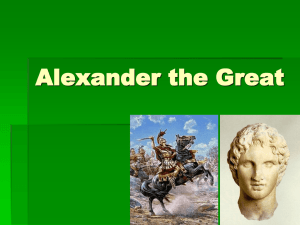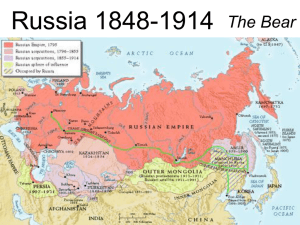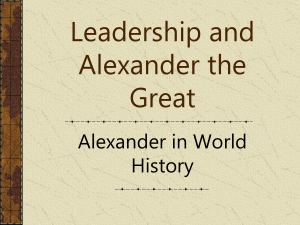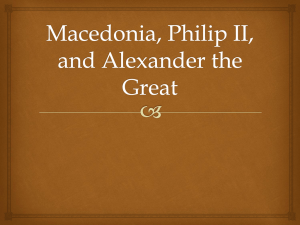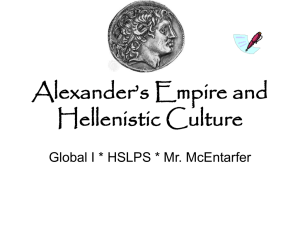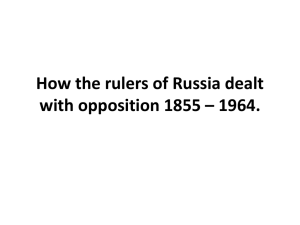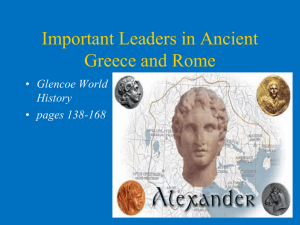Portraits of Alexander the Great
advertisement
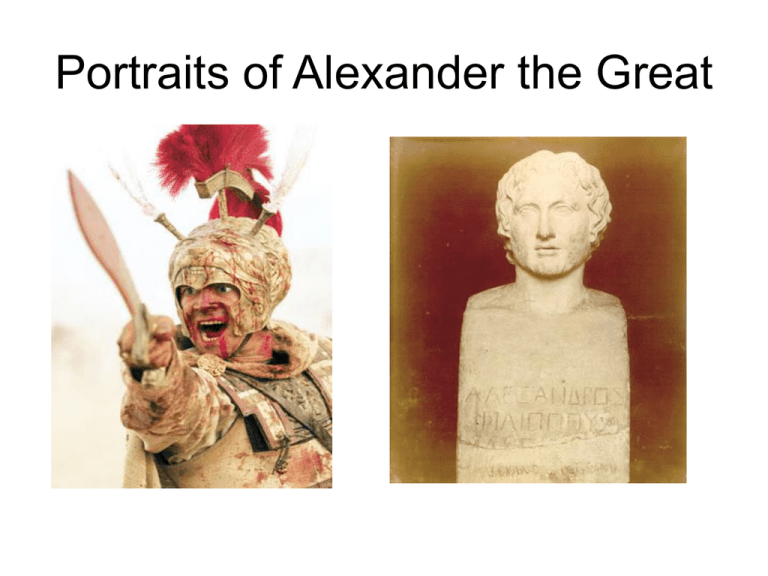
Portraits of Alexander the Great Ancient authors Plutarch on the famous “tilt”: Alexander’s features are best depicted in those statues of him made by Lysippus, the only artist by whom Alexander felt he should be sculpted. As a matter of fact, the features which most of the successors and Alexander’s friends later tried to affect have been accurately caught by the artist: the angle of the neck, slightly inclined to the left, and the languishing glance of the eyes. Alexander 4 Plutarch on complexion and “fragrance”: Apelles [the painter] … failed to capture his complexion, making it too dark and swarthy … Alexander was fair-skinned, but his pale coloration became ruddy, particularly in the chest area but also in the face. … I have read that an agreable odour emanated from his skin and that his breath and whole physique had a fragrance that pervaded his clothes. Alexander 4 Alexander’s trademark hair-style: “the cow’s lick” They say that Alexander, son of Philip, enjoyed natural good looks, with curly, fair hair, but they add there was something in his appearance that aroused fear. Aelian, Varia Historia 12 He himself was of sharp expression and had a somewhat aquiline nose … he made his hair curl upwards and lie back and away from his face. Itinerary of Alexander 6 Portrait 1 of Alexander 340-330 BC • Found near the Erectheion, Athens,1886 • Pentelic marble • Height : 0.35 m. • Identified as Alexander on the basis of similarities with the Herm of Azara (Louvre), inscribed “Alexander, [son] of Philip, Macedon.” Typical portrait features • Slight torsion of the neck, the head tilted upward – reflective of a physical peculiarity or of Alexander’s close link to the gods/Zeus • Clean-shaven, unlike his father, Philip • Luxuriant hair, swept back in a cowlick, giving a leonine appearance • Deep-set eyes shadowed by a prominent brow, adding intensity to youthful energy • Perhaps a hint of sensuality, of future susceptibility to eastern luxury in the full lips. Acropolis Alexander in profile The tapering of the hair at midhead indicates the earlier presence of a wreath or band. Portrait 2 of Alexander early 3rd century BC • Found near Pella, in northern Greece • Marble • Height: 0.32 m. Typical portrait features • Very distinctive inclination of the head • Thick, tousled mane of hair, suggestive of youthful energy and virility, combed back to reveal and offer contrast to the smooth beauty of the face • Shadowed eyes and a slightly open mouth, down-turned, perhaps hinting at a potentially tendency towards melancholy Portraits 3 -Numismatic art • Minted in Memphis • Weight: c. 17 g. • Obverse: beardless Herakles, wearing a lionskin • Reverse: Zeus seated on throne, holding eagle and sceptre • approx. 330BC Silver tetradrachm of Lysimachus of Thrace 305-281 BC • Minted in Alexandria Troas • Weight: c. 17 g. • Obverse: head of Alexander, wearing diadem, with horn of Ammon • Reverse (not shown): Athene seated with shield, holding Nike. Silver tetradrachm of Ptolemy of Egypt 305-283 BC • Minted in Alexandria, Egypt • Weight: c. 17 g. • Obverse: head of Alexander, wearing elephant scalp and aegis • Reverse: Athene standing, hurling spear. Coins - summary • The coins of the successors are minted for propaganda purposes and provide an idealised, youthful image of Alexander • Alexander, now deified, properly replaces the image of a deity. • “Portraits” are romanticised, although the prominent brow, deep-set eyes and full lips regularly feature. The Alexander mosaic - Pompeii • Found in the House of the Faun, Pompeii • Dating to the 2nd century BC, but probably based on a more or less contemporary Greek painting Detail insights • Alexander appears to be grimly focussed on his opponent, Darius – wide-eyed, fixated, pupils enlarged. • His lips are full, but curling downward, in a fiercely determined expression; his nose straight and prominent. • His hair is quite dark, but relieved by golden highlights and swept back, emphasising the speed and force of the charge forward – perhaps “leonine”. Alexander’s height • No art work conveys Alexander’s height. He was certainly smaller than Hephaistion. • Two anecdotes are recorded about his small stature: Sisygambis, captured at Issus, does obeisance before Hephaistion, because he is the more imposing figure. Quintus Curtius Rufus, 3.12 When Alexander sits on Darius’ throne his feet dangle, so a Page places a table under his feet to support them. Diodorus Siculus, 17.66 Two modern contrasting views • Ian Worthington: He did not have the looks of a model: his neck appeared to the left so his face appeared lop-sided and his eyes were watery … he had a long thin nose and his forehead bulged above the eyes. • Robin Lane Fox: Like his father, he was a very handsome man. His nose … was straight, his forehead was prominent and his chin short but jutting. His mouth revealed emotion.



